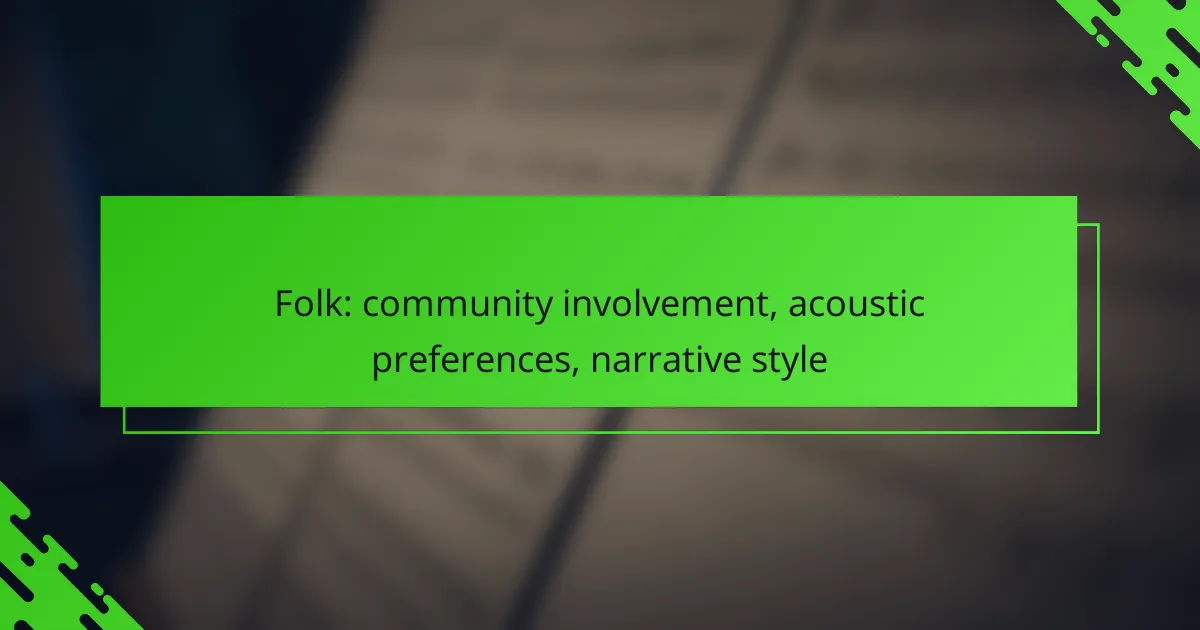Folk music in Canada thrives on community involvement, fostering connections between local artists and audiences that enrich the cultural landscape. With a strong preference for acoustic sounds and traditional instrumentation, this genre showcases the country’s diverse regional influences. The narrative style prevalent in Canadian folk emphasizes storytelling and personal experiences, weaving a rich tapestry of songs that reflect the unique histories of its communities.

How can community involvement enhance folk music in Canada?
Community involvement can significantly enhance folk music in Canada by fostering connections among local artists and audiences. Engaging the community creates a vibrant ecosystem where traditional sounds and contemporary influences blend, enriching the cultural landscape.
Local festivals and events
Local festivals and events serve as vital platforms for folk music, bringing together artists and audiences in a celebratory atmosphere. These gatherings often feature performances, workshops, and jam sessions, allowing musicians to showcase their talents and collaborate with others.
For instance, events like the Vancouver Folk Music Festival or the Mariposa Folk Festival provide opportunities for emerging artists to gain exposure and connect with established musicians. Attending these festivals can help build a sense of community and encourage the preservation of folk traditions.
Collaborative songwriting workshops
Collaborative songwriting workshops are effective ways to engage community members in the creative process of folk music. These workshops often invite participants to share their stories and experiences, which can inspire new songs that reflect local culture and values.
By facilitating collaboration among diverse voices, these workshops can lead to unique compositions that resonate with the community. They also provide a supportive environment for budding songwriters to develop their skills and gain confidence in their artistry.
Community radio stations
Community radio stations play a crucial role in promoting folk music by providing a platform for local artists to reach wider audiences. These stations often feature programs dedicated to folk genres, showcasing both traditional and contemporary works from the region.
Listeners can discover new talent and gain insights into the local music scene, fostering a deeper appreciation for folk music. Supporting community radio can help ensure that diverse voices and stories continue to be heard, enriching the overall folk music landscape in Canada.

What are the acoustic preferences in Canadian folk music?
Canadian folk music is characterized by a strong preference for acoustic sounds that emphasize natural tones and traditional instrumentation. This genre often reflects the cultural diversity of Canada, showcasing various regional influences that shape its unique acoustic landscape.
Use of acoustic instruments
Acoustic instruments are central to Canadian folk music, with guitars, fiddles, banjos, and mandolins commonly featured. These instruments create a warm, inviting sound that resonates with audiences, often enhancing the storytelling aspect of the music. Many artists prefer using handmade or locally sourced instruments to maintain authenticity and connection to their roots.
Preference for natural sound
There is a notable preference for natural sound in Canadian folk music, which often avoids heavy electronic production. This approach allows the raw emotion of the lyrics and melodies to shine through, fostering a deeper connection with listeners. Artists frequently record in natural settings or use minimal processing to preserve the organic quality of their sound.
Influence of regional styles
Regional styles significantly influence the acoustic preferences in Canadian folk music, with variations reflecting local traditions and cultural backgrounds. For example, the East Coast may incorporate Celtic influences, while Indigenous music often features unique rhythms and instruments. This diversity enriches the folk genre, allowing for a wide range of acoustic expressions across the country.

What narrative styles are prevalent in Canadian folk music?
Canadian folk music often features narrative styles that emphasize storytelling, personal experiences, and cultural themes. These elements create a rich tapestry of songs that reflect the diverse experiences and histories of communities across Canada.
Storytelling through lyrics
Storytelling is a cornerstone of Canadian folk music, where lyrics often narrate tales of everyday life, love, and hardship. Artists use vivid imagery and relatable characters to engage listeners, making the songs feel personal and immersive. For example, songs may recount the journey of a farmer or the struggles of a family, resonating deeply with audiences.
Many folk songs incorporate local dialects and idioms, enhancing the authenticity of the narrative. This connection to place and experience makes the storytelling aspect particularly compelling in Canadian folk music.
Focus on personal experiences
Personal experiences are frequently at the heart of Canadian folk songs, allowing artists to share their own stories and emotions. This focus creates a sense of intimacy, as listeners can relate to the feelings expressed in the music. Themes such as love, loss, and resilience are common, often drawing from the artist’s own life or the lives of those around them.
By sharing personal narratives, folk musicians foster a communal atmosphere where listeners feel connected not only to the artist but also to each other. This shared experience is a vital aspect of folk music culture in Canada.
Historical and cultural themes
Canadian folk music often explores historical and cultural themes, reflecting the country’s diverse heritage. Songs may address events such as the fur trade, Indigenous histories, or immigration stories, providing insight into the collective memory of various communities. This historical context enriches the music, making it a vehicle for preserving cultural identity.
Additionally, folk songs can serve as a form of social commentary, highlighting issues such as social justice and environmental concerns. By weaving these themes into their narratives, Canadian folk musicians contribute to an ongoing dialogue about the nation’s past and present.

How does folk music reflect Canadian identity?
Folk music serves as a vital expression of Canadian identity by showcasing the country’s diverse cultural heritage, connection to its natural landscapes, and the preservation of indigenous narratives. Through storytelling and acoustic traditions, folk music encapsulates the experiences and values of various communities across Canada.
Representation of diverse cultures
Folk music in Canada reflects its multicultural society by incorporating elements from various ethnic groups, including Indigenous, French, British, and immigrant communities. Each culture contributes unique instruments, rhythms, and lyrical themes that enrich the folk music landscape.
For example, the use of the fiddle in Maritime folk music highlights Scottish and Irish influences, while Métis music often features the traditional use of the guitar and the spoons. This blend creates a vibrant tapestry that celebrates Canada’s cultural diversity.
Connection to nature and landscapes
Canadian folk music often draws inspiration from the country’s vast and varied landscapes, including mountains, forests, and lakes. Songs frequently depict the beauty of nature and the experiences of those who live in rural areas, fostering a deep connection between the music and the land.
Artists like Gordon Lightfoot and Stan Rogers have famously captured the essence of Canadian geography in their lyrics, evoking imagery that resonates with listeners. This connection to nature not only reflects the physical environment but also the emotional ties that Canadians have to their surroundings.
Preservation of indigenous stories
Folk music plays a crucial role in preserving Indigenous stories and traditions, serving as a medium for passing down oral histories and cultural teachings. Indigenous musicians often incorporate traditional storytelling techniques into their songs, ensuring that their heritage remains alive and relevant.
Through collaborations with non-Indigenous artists and participation in folk festivals, Indigenous musicians are able to share their narratives with a broader audience, fostering understanding and appreciation of their cultures. This exchange not only enriches the folk music scene but also promotes reconciliation and respect for Indigenous rights and histories.

What are the best platforms for discovering Canadian folk music?
The best platforms for discovering Canadian folk music include streaming services, local music blogs, and social media groups. Each of these platforms offers unique ways to explore artists, albums, and community events that highlight the rich tapestry of Canadian folk culture.
Streaming services like Spotify
Streaming services such as Spotify provide extensive libraries of Canadian folk music, allowing users to discover both popular and emerging artists. Playlists curated specifically for folk genres can help listeners find new favorites quickly.
Utilizing features like personalized recommendations and genre-specific playlists can enhance your listening experience. Look for playlists that focus on Canadian folk to get a sense of the diversity within the genre.
Local music blogs and websites
Local music blogs and websites are excellent resources for discovering Canadian folk music. These platforms often feature artist interviews, album reviews, and concert listings that highlight regional talent.
Examples include blogs dedicated to Canadian music scenes or specific provinces, which can provide insights into local events and lesser-known artists. Regularly checking these sites can keep you updated on the latest in the folk music community.
Social media groups and pages
Social media groups and pages focused on Canadian folk music can connect you with other enthusiasts and artists. Platforms like Facebook and Instagram often host communities where fans share music recommendations, concert experiences, and discussions about the genre.
Joining these groups can lead to discovering new artists and upcoming events. Engaging with posts and participating in discussions can deepen your appreciation for the folk music scene in Canada.

How can e-commerce support folk artists in Canada?
E-commerce can significantly enhance the visibility and sales potential of folk artists in Canada by providing platforms to sell merchandise and distribute music digitally. By leveraging online tools, these artists can reach wider audiences and generate income without the constraints of traditional retail environments.
Online merchandise sales
Online merchandise sales allow folk artists to sell products such as clothing, posters, and handmade crafts directly to fans. Platforms like Shopify or Etsy can be effective for setting up an online store, enabling artists to showcase their unique items and connect with their audience.
When selling merchandise, consider factors like shipping costs, pricing strategies, and product quality. Offering limited edition items or bundles can create urgency and encourage purchases. It’s also essential to promote these products through social media to drive traffic to the online store.
Digital music distribution
Digital music distribution enables folk artists to share their music globally through platforms like Spotify, Apple Music, and Bandcamp. These services allow artists to upload their tracks and reach listeners without the need for physical copies, which can be costly and time-consuming to produce.
Artists should consider using a digital distribution service that fits their needs and budget. Many services take a percentage of sales or charge a flat fee, so it’s important to compare options. Additionally, promoting new releases through email newsletters and social media can help increase streams and downloads.
